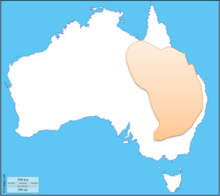Spotted bowerbird
| Spotted bowerbird | |
|---|---|
 |
|
| Scientific classification | |
| Kingdom: | Animalia |
| Phylum: | Chordata |
| Class: | Aves |
| Order: | Passeriformes |
| Family: | Ptilonorhynchidae |
| Genus: | Chlamydera or Ptilonorynchus |
| Species: | C. maculata or P. maculatus |
| Binomial name | |
|
Chlamydera maculata or Ptilonorynchus maculatus (Gould, 1837) |
|
 |
|
| Distribution of the spotted bowerbird | |
| Synonyms | |
|
large-frilled bowerbird, cabbage-bird or mimic-bird. |
|
large-frilled bowerbird, cabbage-bird or mimic-bird.
The spotted bowerbird (Ptilonorynchus maculatus) or (Chlamydera maculata) is a sedentary, mid-sized passerine found across broad parts of the drier habitats of eastern Australia. The species is known for its remarkable behaviours, like many other bowerbirds (Ptilonorynchidae), which include bower building and decorating, courtship displays and vocal mimicry. Spotted bowerbirds are locally common, however, overall the population is thought to be in decline.
At 29 cm in length, spotted bowerbirds are intermediate in size among the bowerbirds, but are rather slim and compact. Spotted bowerbirds are sexually monomorphic, with a pale rufous head that is streaked with grey-brown and a nape adorned with a lilac-pink crest. The upperparts are blackish-brown and marked extensively with amber spots, while the paler underparts are cream with greyish scalloping and barring and a slightly yellow shade to the lower belly and undertail. The bill is black, the eyes dark brown and the legs olive-brown.
Spotted bowerbirds have a diverse range of vocalisations. Typical calls include loud, harsh churrings and other notes, as well as the complex vocal mimicry characteristic of grey bowerbirds. Spotted bowerbirds are accomplished vocal mimics and have been known to simulate the calls of many birds as well as other sounds. When approached by humans or other potential threats, males at bowers and females at nests often mimic the calls of predatory birds such as the wedge-tailed eagle (Aquila audax), blue-winged kookaburra (Dacelo leachii), grey-crowned babbler (Pomatostomus temporalis), grey butcherbird (Cracticus torquatus), pied butcherbird (Cracticus nigrogularis), australian magpie (Gymnorhina tibicen), australian raven (Corvus coronoides), apostlebird (Struthidea cinerea) and honeyeaters (Meliphagidae spp.) among others. Other sounds mimicked include large herbivores moving through scrub or over fallen branches, the twang of fence wire, wood chopping, the crack of stock whip and the whistling flight of crested pigeons.
...
Wikipedia

